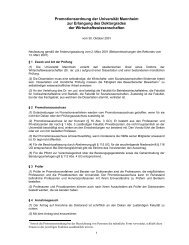The returns to cognitive and non-cognitive abilities in Germany
The returns to cognitive and non-cognitive abilities in Germany
The returns to cognitive and non-cognitive abilities in Germany
Create successful ePaper yourself
Turn your PDF publications into a flip-book with our unique Google optimized e-Paper software.
consequences from actions beyond the own behavior <strong>and</strong> control. It cont<strong>in</strong>ues <strong>to</strong> be the<br />
strongest predic<strong>to</strong>r for wage differentials among all personality traits <strong>in</strong>cluded. In particular,<br />
an <strong>in</strong>crease <strong>in</strong> worker’s external locus of control by one st<strong>and</strong>ard deviation results <strong>in</strong> wage<br />
premiums of about 6% for females <strong>and</strong> even more than 7% for males (Table 2, columns 2<br />
<strong>and</strong> 4).<br />
Turn<strong>in</strong>g <strong>to</strong> the results for <strong>in</strong>dividuals’ <strong>cognitive</strong> <strong>abilities</strong>, the f<strong>in</strong>d<strong>in</strong>gs from the panel<br />
regressions re<strong>in</strong>force the above provided OLS results. Aga<strong>in</strong>, there is no statistical<br />
relationship between the scores from the symbol correspondence test <strong>and</strong> the wages of<br />
female workers. <strong>The</strong> wages of males however <strong>in</strong>crease with fluid <strong>in</strong>telligence. <strong>The</strong> SCT<br />
coefficients are even slightly larger when compared <strong>to</strong> the coefficients <strong>in</strong> the basel<strong>in</strong>e OLS<br />
estimations. <strong>The</strong> wage premiums now are at about 3% <strong>in</strong> both the RE <strong>and</strong> the HTIV<br />
regressions (Table 2, columns 3 <strong>and</strong> 4).<br />
To further account for possible <strong>non</strong>-l<strong>in</strong>earities <strong>in</strong> the relationship between <strong>cognitive</strong><br />
<strong>abilities</strong>, personality <strong>and</strong> wages, we ran additional regressions that <strong>in</strong>clude dummies on<br />
whether the respondent scores either <strong>in</strong> the bot<strong>to</strong>m or <strong>to</strong>p 25% of the particular trait. <strong>The</strong><br />
results from these exercises are given <strong>in</strong> Table 3 which <strong>in</strong>cludes the results from the pooled<br />
OLS <strong>and</strong> the HTIV estimations. 16 Judged by signs only, there are u-shaped gradients for<br />
conscientiousness, extraversion, <strong>and</strong> neuroticism <strong>in</strong> females’ wages. However, this evidence<br />
is not overly strong <strong>in</strong> terms of statistical significance: only for the latter <strong>and</strong> only <strong>in</strong> the<br />
pooled cross-sectional model is there statistical significance for both the bot<strong>to</strong>m <strong>and</strong> the <strong>to</strong>p<br />
25% covariates.<br />
<strong>The</strong> f<strong>in</strong>d<strong>in</strong>gs are somewhat similar for males <strong>in</strong>asmuch as the signs of the coefficients<br />
h<strong>in</strong>t <strong>to</strong>wards <strong>non</strong>-l<strong>in</strong>ear effects. However, there are hump-shaped gradients for openness,<br />
extraversion, <strong>and</strong> neuroticism. Aga<strong>in</strong>, the evidence is statistically not very conv<strong>in</strong>c<strong>in</strong>g except<br />
for extraversion <strong>in</strong> the pooled OLS model. This result <strong>in</strong>dicates that scor<strong>in</strong>g either <strong>in</strong> the<br />
23















